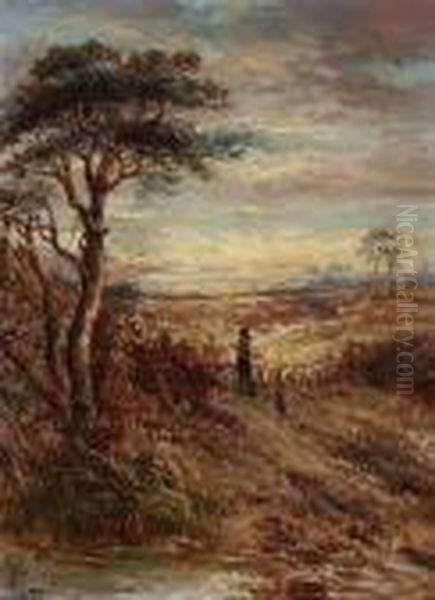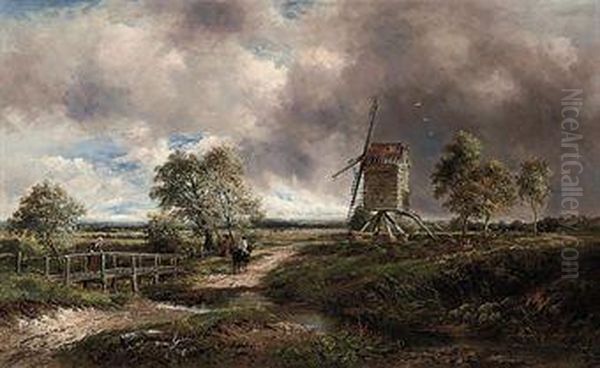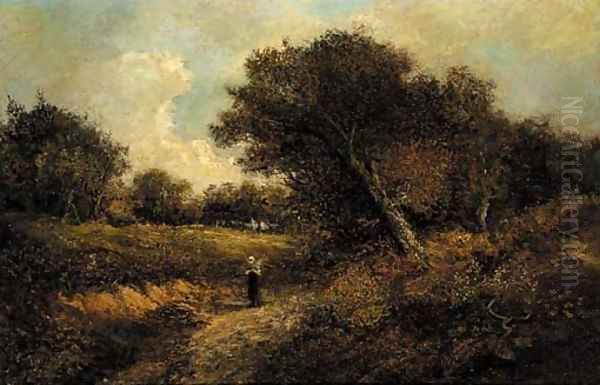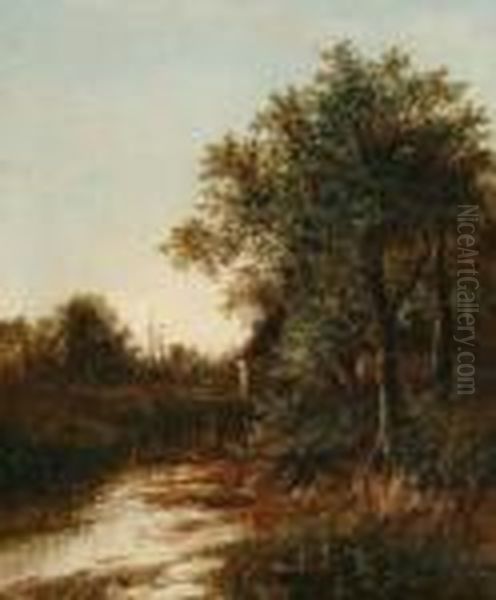Joseph Thors stands as a notable figure within the rich tapestry of 19th-century British landscape painting. Active during a period of significant artistic evolution and societal change, Thors carved a niche for himself with his serene and meticulously observed depictions of the English countryside. Though perhaps not as revolutionary as some of his contemporaries, his work offers a valuable window into the prevailing tastes and artistic currents of the Victorian era, particularly the enduring appeal of naturalism and the idyllic rural scene. His association with the Birmingham School further cements his place in the regional and national art history of Britain.
A Continental Birth, A British Career
An intriguing aspect of Joseph Thors' biography is his origin. Born in Amsterdam, the Netherlands, around 1835, he eventually established his artistic career entirely within Britain. This Dutch beginning raises interesting questions about his early influences, potentially exposing him to the legacy of the great 17th-century Dutch landscape masters like Jacob van Ruisdael or Meindert Hobbema, whose detailed renderings of trees, skies, and rural life find echoes in Thors' later work.
However, historical records firmly place his professional life in England. He became a British national and was primarily based in London, though his artistic focus often centered on the Midlands, particularly the areas around Birmingham. This transition from the Netherlands to Britain highlights the magnetic pull of the London art world and the opportunities available for skilled painters in the prosperous Victorian economy. Thors successfully integrated into the British art scene, adopting the subjects and styles that resonated with local audiences and institutions.
The Victorian Artistic Context: Naturalism's Appeal
Joseph Thors' active period, roughly from the 1860s through to 1900, coincided with the high noon of the Victorian era in Britain. This was a time marked by rapid industrialization, urban growth, and profound social change. Paradoxically, this progress often fueled a sense of nostalgia and a yearning for the perceived simplicity and tranquility of rural life. Landscape painting, particularly scenes depicting peaceful countryside untroubled by industry, found a receptive audience among the growing middle and upper classes.

Naturalism, as an artistic approach emphasizing the faithful and detailed representation of the observable world, was a dominant force. It stood in contrast to the dramatic sublimity of earlier Romantic painters like J.M.W. Turner, offering instead a quieter, more intimate connection with nature. While movements like the Pre-Raphaelite Brotherhood, with figures such as Dante Gabriel Rossetti and John Everett Millais, explored different avenues of detail and symbolism, the straightforward depiction of landscape held enduring popularity. Thors operated squarely within this naturalistic tradition.
Affiliation with the Birmingham School
Joseph Thors is consistently identified as a member of the Birmingham School of artists. This regional group, flourishing in the mid-to-late 19th century, was particularly known for its focus on landscape painting, carrying forward a tradition influenced by earlier figures like David Cox, who had strong ties to the area. The Birmingham School artists generally shared a commitment to naturalism, detailed observation, and the depiction of the local Midland scenery.
Membership in this school placed Thors within a community of like-minded artists, likely including figures associated with the broader Birmingham art scene such as Walter Langley (though more known for his Newlyn School work later) or William John Wainwright. They emphasized craftsmanship and a direct engagement with nature, often depicting rustic scenes, woodlands, and waterways with considerable skill. Thors' work exemplifies the core tenets of the school: a dedication to representing the textures, light, and atmosphere of the English countryside in a realistic yet often picturesque manner.
Stylistic Kinship with the Norwich School
Interestingly, while firmly part of the Birmingham School, Thors' artistic style is frequently compared to that of the earlier Norwich School. Active primarily in the first half of the 19th century, the Norwich School, led by figures like John Crome and John Sell Cotman, was one of England's first regional art movements. They specialized in depicting the landscapes of East Anglia, characterized by their intimate scale, subtle handling of light and atmosphere, and detailed yet unpretentious naturalism.
The comparison is apt. Thors' paintings often share the Norwich School's preference for unassuming rural subjects over grand vistas. His focus on the play of light on foliage, the careful rendering of trees (old birch trees appear in descriptions of his work), the inclusion of quiet figures or animals within the landscape, and the overall serene mood echo the sensibilities of Crome and Cotman. This suggests Thors drew inspiration from this earlier tradition of English landscape painting, adapting its principles to his own Midland subjects.
Artistic Style: Detail, Serenity, and Rural Motifs

The defining characteristic of Joseph Thors' art is its detailed naturalism applied to idyllic rural scenes. He possessed a keen eye for the specifics of the landscape – the gnarled bark of an ancient tree, the texture of thatch on a cottage roof, the gentle ripple of water in a stream, the dampness of a country lane after rain. His brushwork, while often visible, was primarily employed to build up these textures and details accurately.
His compositions typically feature elements that became hallmarks of his style: rustic cottages nestled amongst trees, winding paths or tracks leading the viewer's eye into the scene, often populated by solitary figures or small groups engaged in quiet rural activities, and frequently including domestic animals like cattle or sheep. These elements combine to create a sense of peace, stability, and gentle harmony between humanity and nature.
Thors favoured a relatively subdued palette, dominated by greens, browns, and earth tones, appropriate for the English countryside. His handling of light tends towards the soft and diffused, often capturing the gentle sunlight of morning or late afternoon, contributing to the overall tranquil and sometimes contemplative atmosphere of his work. While meticulously detailed, his paintings generally avoid high drama or overt emotionalism, focusing instead on the quiet beauty of the everyday rural world.
Representative Works and Recurring Themes
While a comprehensive catalogue raisonné might be elusive, several titles and descriptions give a clear picture of Thors' output. Works like Extensive English Landscape with a Man on a Pathway encapsulate his typical compositional structure – a broad view anchored by a human element integrated into the natural setting. A Country Track, depicting a woman walking along a shaded lane towards distant cottages, highlights his recurring motif of pathways and the suggestion of rural community.
Another described work, Fine Oil Painting on Canvas, featuring cattle grazing near a lake under old birch trees, showcases his skill in rendering animals and specific types of foliage, contributing to the scene's naturalistic credibility. These examples reinforce the prevalence of certain themes: the journey (paths, tracks), rustic dwellings (cottages), the presence of domesticated animals, and the overarching embrace of nature, often represented by prominent trees.

Although specific current locations for many of his works, including Extensive English Landscape... and A Country Track, are not readily documented in easily accessible sources (common for artists whose works are primarily in private hands or regional collections), the record that the Fine Oil Painting on Canvas was destined for Saint Gabriel, Louisiana, indicates the reach his paintings achieved, likely through commercial galleries and private sales. His works continue to appear at auction houses, demonstrating an ongoing market interest.
Exhibitions, Recognition, and Patronage
Joseph Thors was an active participant in the established art exhibition system of Victorian Britain. His documented exhibition history spans from 1863 to 1900, a significant period indicating a sustained career. He showed his works at prestigious London venues, including the Royal Academy of Arts, the British Institution, and the galleries on Suffolk Street (home to the Society of British Artists). He also exhibited in Birmingham, reflecting his ties to the city's art scene.
Exhibiting at these institutions was crucial for an artist's reputation and commercial success. It brought his work to the attention of critics, fellow artists, and potential buyers. The consistent acceptance of his paintings suggests they met the standards and tastes favoured by the selection committees of the time. His naturalistic, picturesque landscapes appealed to patrons, often from the affluent urban classes, who sought images of rural tranquility as an antidote to the increasingly industrialized world. While perhaps not achieving the fame of the era's leading figures, Thors clearly found a respectable place within the art market.
Contemporaries, Influences, and Artistic Dialogue
Thors worked during a vibrant period for British landscape painting. Besides the Birmingham School artists and the historical influence of the Norwich School and potentially Dutch masters, he shared the artistic stage with numerous contemporaries. Painters like Benjamin Williams Leader, known for his highly detailed and popular views of the English and Welsh countryside, or Alfred de Bréanski Sr., who also specialized in picturesque landscapes, were active during Thors' career and catered to similar tastes.
The mention of a collaborative work with another painter, George Boyle, offers a rare glimpse into his direct professional interactions. Such collaborations, while not uncommon, suggest a degree of collegiality and shared artistic endeavour. Thors' style, however, remained distinct – less overtly dramatic than some, perhaps more focused on the intimate and atmospheric qualities of the landscape, aligning him more closely with the enduring tradition of detailed naturalism than with emerging trends like Impressionism, which began to make inroads in Britain towards the end of his exhibiting career.
Critical Reception and Legacy

The critical assessment of Joseph Thors, both during his lifetime and subsequently, tends to acknowledge his technical skill and his genuine affinity for the subjects he painted. He was praised for his careful observation and his ability to capture the specific character of the English countryside. His works were seen as well-crafted, pleasing, and representative of a popular genre. They fulfilled the desire for accessible, naturalistic depictions of rural life.
However, this focus on detailed representation and serene atmosphere sometimes led to criticism, or perhaps simply a classification, that his work might lack the profound emotional depth, intellectual complexity, or innovative vision found in the art of more groundbreaking figures. His paintings are generally seen as embodying competence and charm rather than challenging artistic boundaries.
Compounding this is the relative scarcity of information about his personal life. Unlike artists who cultivated strong public personas or left behind extensive writings, Thors appears to have been a more private figure. Few personal anecdotes or art world rumors seem to have attached themselves to his name, leaving his legacy largely defined by the consistent body of work he produced.
Today, Joseph Thors is appreciated as a significant exponent of late Victorian landscape painting, particularly within the context of the Birmingham School. His works are valued for their evocative portrayal of a bygone English rural landscape, executed with considerable skill and sensitivity. They remain popular with collectors who appreciate traditional landscape art and offer art historians valuable examples of the naturalistic current that persisted alongside other artistic developments in the 19th century.
Conclusion: Capturing the Quiet Countryside
Joseph Thors dedicated his career to capturing the quiet beauty of the English rural landscape. Born in the Netherlands but fully integrated into the British art world, he became a key figure associated with the Birmingham School, sharing stylistic affinities with the earlier Norwich School. His paintings, characterized by detailed naturalism, serene atmospheres, and recurring motifs of cottages, paths, and trees, found favour with Victorian audiences and institutions like the Royal Academy. While perhaps lacking the dramatic flair or innovative drive of some contemporaries, Thors excelled in producing consistently well-crafted and evocative scenes that celebrated the enduring appeal of nature. His work remains a testament to the skill and sensibility of a dedicated landscape artist and provides a valuable perspective on the artistic tastes of his time.